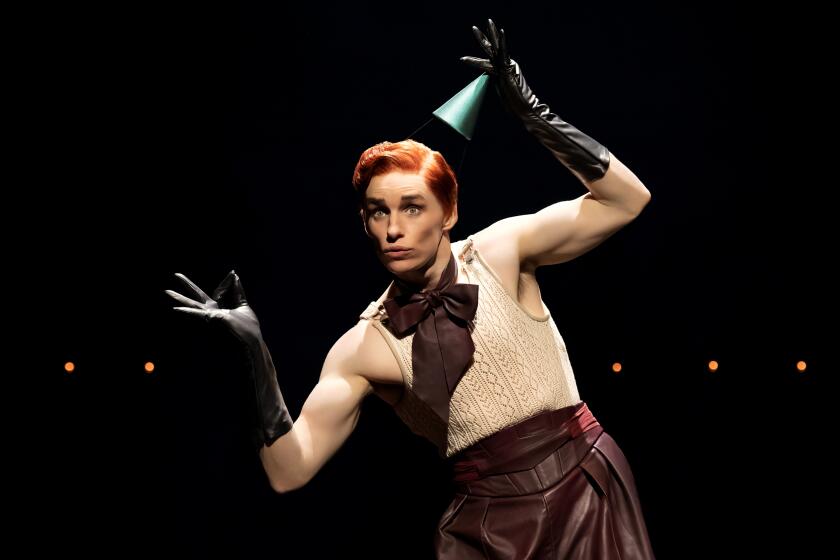Art review: Michael Heizer has long been thinking big
Now that “Levitated Mass,” the much-publicized megalith poised atop a steel-reinforced concrete channel, has opened on the grounds of the Los Angeles County Museum of Art, an earlier work also by artist Michael Heizer has been temporarily installed in the adjacent Resnick Pavilion.
“Actual Size: Munich Rotary” (1971) is in some respects a cleaner, more precise embodiment of the same artistic principles that support the giant rock outdoors.
Simply put: Advanced technology meets primal nature. The quiet, grinding friction between them sets off imaginative sparks.
PHOTOS: ‘Levitated Mass’ opens at LACMA
Borrowed from the collection of New York’s Whitney Museum, the rarely seen installation was fully restored at LACMA for the occasion. With the aid of intense light and special lenses, six enormous images are projected on two long, tall walls by big steel projectors. (They look something like oversized toasters from a truck-stop diner.) Each one holds a photographic positive on a glass plate, and together they record a continuous landscape.
Disconcertingly, the landscape images are the exact same size as the actual landscape in Munich that Heizer photographed in 1969. A pebble or a horizon in the picture and a pebble or a horizon in the spot where the photograph was taken correlates one-to-one.
Yet, the experience is not like being there. Scrutiny instead abstracts the view. Approach the black-and-white picture and the sharp focus dissolves; your shadow interrupts the scene. The depicted world recedes, becoming less clear, not more.
FULL COVERAGE: LACMA’s big rock
The machinery of picture-making becomes its subject. Heizer’s installation is a modern panorama, a form that originated at the end of the 18th century.
Panoramas are ancestors of Cinerama and Imax movies. Itinerant English painter Robert Barker (1739-1806) painted scenes of Edinburgh, Scotland, inside a big cylinder that a paying customer could enter to take in the 360-degree view. Even today the painted Velaslavasay Panorama can be visited in the old Union Theater in L.A.’s West Adams neighborhood.
Panoramas were picturesque, but Heizer’s installation pulls the plug on romantic daydreams. It documents a bleak pit dug as his first German solo exhibition: A thousand tons of earth were removed in a conical shape 100 feet across and 16 feet deep. “Munich Depression” — the title reads as a glum double-entendre, intentional or not — is a sculptural form composed from negative space.
Heizer photographed it while standing at the bottom of the man-made pit, rotating around the circular space. Spliced-together views show sloping walls of dirt, marked here and there by heavy-machinery tracks. A flat gray sky rises above the irregular horizon line, and industrial cranes peek over the rim.
Like “Levitated Mass,” the installation is sepulchral. A viewer is visually located below ground, as if in a grave, while physically located inside a darkened museum room, surrounded by sophisticated image-making equipment. Just a year or so before “Actual Size: Munich Rotary” was made, a man landed on the moon. The work heightens an experience of alienation from both nature and technology.
The installation would likely be even more effective in a square room, where its rotary qualities would be self-evident. (In “Actual Size” upstairs at LACMA’s Broad Contemporary Art Museum, 15 Heizer photographs show massive boulders in the landscape.) Still, the work is effective. It resonates with the current Museum of Contemporary Art survey, “Ends of the Earth: Land Art to 1974,” which explores how photographic media, traditional gallery spaces and urban environments were instrumental in shaping an art usually thought of as existing in remote environments. Sometimes wilderness is all in your head.
Michael Heizer: “Actual Size” and “Actual Size: Munich Rotary,” Los Angeles County Museum of Art, 5905 Wilshire Blvd., (323) 857-6000, through Sept. 9. Closed Wednesday. https://www.lacma.org
christopher.knight@latimes.com
More to Read
The biggest entertainment stories
Get our big stories about Hollywood, film, television, music, arts, culture and more right in your inbox as soon as they publish.
You may occasionally receive promotional content from the Los Angeles Times.







